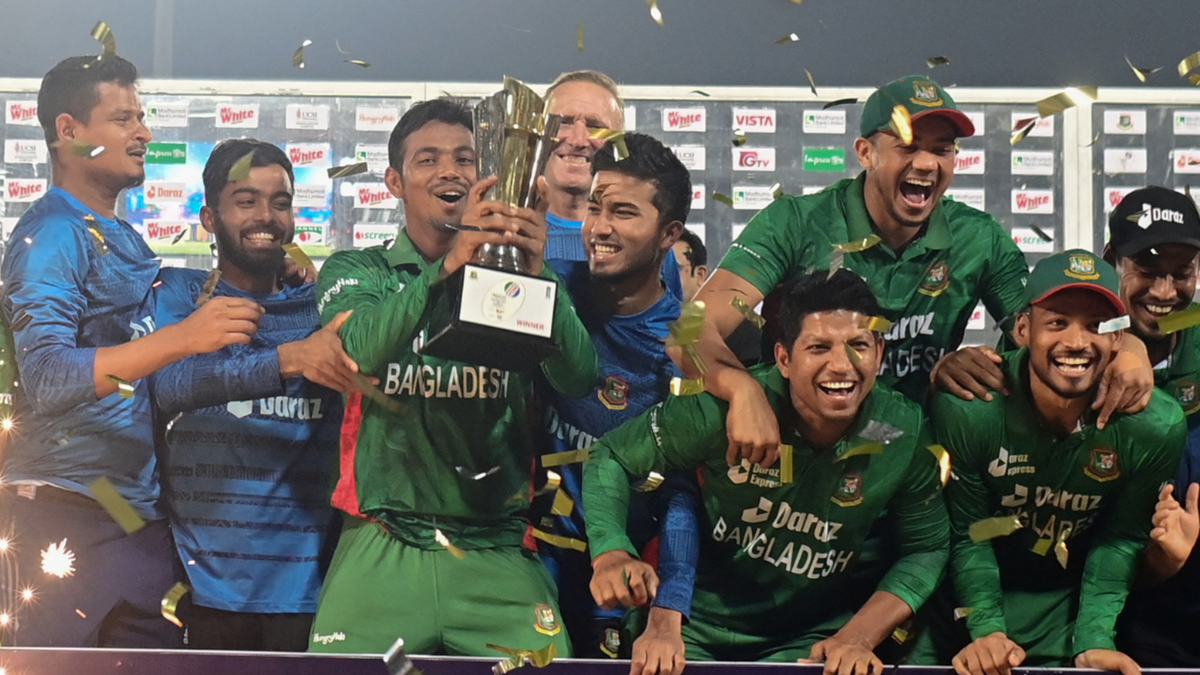
If you hadn’t noticed, Bangladesh are now one of the best white-ball sides in the world – at home at least.
Since the start of 2019, their win/loss ratio in home T20Is is 2.00 – the third highest among Full Members, with only Australia and India above them. In ODIs, their excellence goes back even further. Since the 2015 World Cup, they have lost just two home series – each to England – beating India twice and Pakistan in that time.
Yesterday (March 14), they recorded a famous series whitewash against England, capping off a historic maiden series win over England in dominant style. Bangladesh swatted away the world champions, and it wasn’t particularly close, the Tigers chasing down 118 in the second T20I to spark joyous scenes. It was a deserved victory, even if England did end up with a depleted squad featuring just four specialist batters. But the manner of the wins also hints at why Bangladesh haven’t translated their undoubted success at home into anything more substantial at a global tournament.
Simply put, white-ball cricket in Bangladesh – and particularly T20 cricket – is unlike that played anywhere else in the world. Spin dominates and scoring rates are low. It’s a type of cricket that Shakib Al Hasan and the rest are masters at. But it arguably doesn’t prepare them for success overseas.
Since the start of 2019, Bangladesh are the only Full Member team to see more than 20 overs per T20I bowled by spinners. Australia, the hosts for the last T20 World Cup, has seen just over 12, while the West Indies and USA, the combined hosts for the next T20 World Cup, have around 13.4 overs of spin.
Spinners have conceded just 6.12 runs per over in Bangladesh in that time, again the lowest for a Full Member, and overall run rates are low. The combined run rate in all T20Is in Bangladesh since the start of 2019 is 6.58 – no other Full Member has a run rate below seven an over. A total of 158-2 in the final T20I against England seemed like a poor use of resources when, in fact, there have been only two higher team scores in T20Is in Bangladesh since the start of 2020.
Yet, across the same time span, Bangladesh are among the weakest tourists in T20I cricket. With 10 wins and 27 defeats, their win/loss record is the second-worst among Full Members, ahead of only the West Indies. Despite their success at home, Bangladesh have not threatened to make the semi-finals of either of the last three T20 World Cups. Shakib has railed against conditions at home as being potentially career-ending for batters.
“Those who played the last nine-ten matches, are all out of form,” he had said after a 4-1 series win over Australia in 2021, during which neither side made it to 130. “That’s how the wicket was. Nobody did well. I hope the batters don’t count this performance. Careers will end if any batter plays 10-15 matches on these wickets. Let’s not take this into account.”
None of this is to diminish Bangladesh’s success at home. The surfaces may divert from the norm, but they are still fair to both sides. It’s a different type of cricket, but it’s still cricket – for spinners, accuracy is paramount, and for batters, the ability to milk spin as well as smash it is key. Nasum Ahmed and Mahedi Hasan have been key, each going at under 5.5 runs per over, with Nasum also proving to be a wicket-taking option, striking every 13.9 balls.
Mustafizur Rahman has shown quicks can prosper too, going at under a run a ball and taking 30 wickets in 22 games. But none of the batting numbers stand out. Litton Das averages 27.46 with a strike rate of 125.60 at home in that time, and each figure is the best of Bangladesh’s regular batting options – but they have had enough players chip in consistently to get up to defendable totals.
And in ODIs, the sense is there of a team who could threaten at this year’s World Cup. Combined scoring rates are still low in Bangladesh, with an average of 27 and a strike rate of just over 80 in the Cricket World Cup Super League, but not outlandishly so. Bangladesh have an OK record away from home, winning 16 and losing 17 in that time. Their five consecutive series wins in 2021 and 2022 included triumphs in Zimbabwe, West Indies and South Africa.
Whether they can translate their home T20I form into all-conditions competitiveness remains to be seen, and the test will come at next year’s T20 World Cup. For now, Bangladesh are winning series and building confidence. Maybe at the moment that’s enough.








